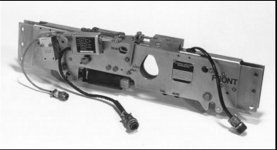


BRU-14/A weapon/stores rack
The BRU-14/A bomb rack is a parent rack which provides for suspension and release of stores weighing up to 2,000-2,200 pounds. Two suspension hooks provide for attachment of weapons or stores having 14-inch suspension lugs. It connects to the aircraft special weapons release and control system to provide primary release, IFOBRL (in-flight operable bomb release lock) actuation, auxiliary unlock, secondary release, and mechanical arming of a weapon/store. Linear Electromechanical Actuator consists of a spring-loaded plunger that is mechanically locked and electrically released, thereby initiating hook release. Aero 1A adapter assemblies may be added to increase the bomb rack to 30-inch suspension capacity. The BRU-14/A is a modified Aero 65A bomb rack which has been adapted for use with P-3C and S-3A aircraft.
Major components consist of a linear electromechanical actuator and an in-flight operable bomb rack lock auxiliary release assembly.
The linear electromechanical actuator consists of a spring-loaded plunger that is mechanically cocked and electrically released to provide the force that initiates hook release. The auxiliary release assembly provides a secondary method of release should the linear electromechanical actuator or its electrical system fail.
The in-flight operable bomb rack lock mechanism consists of a remotely controlled bomb rack lock and emergency release auxiliary unlock. The IFOBRL consists of a lockbar, which pivots on the frame to lock the rear link in latched position, and an actuator assembly, which can be locked or unlocked manually. The auxiliary unlock assembly is a cartridge-actuated device providing a mounting point for the aft end of the IFOBRL. When actuated, the unlock releases the IFOBRL and allows it to move forward, freeing the rear link from restraint. Mechanical arming of a weapon/store is accomplished through two electrically actuated arming solenoids, which are mounted in the frame assembly. The BRU-14 is capable of suspension and release of a weapon/store in either an armed or safe condition. An electrical impulse from the aircraft is used to release the store. Mechanical arming is provided for more and/or tail arming. During ground operations and in flight the IFOBRL provides a positive lock to the release mechanism.
The left inboard, left outboard, and right weapon pylons on the Navy's Light Airborne Multi-Purpose System (LAMPS) Mark III SH-60B Seahawk accommodate BRU-14/A weapon/stores racks. The BRU-14A bomb racks interface with the MK-50 Advanced Lightweight Torpedo (ALWT) and Penguin missile.
Fittings for torpedo parachute release lanyards are located on the fuselage aft of each weapon pylon. Effective on BUNO 162349 and subsequent, the left and right inboard pylons have wiring and tubing provisions for auxiliary fuel tanks. All pylons have wiring provisions to accommodate the MK 50
torpedo. The left outboard weapon pylon can accommodate a missile launch assembly (MLA) which is used to mount the MK 2 MOD 7 Penguin air-to-surface missile.
The PENGUIN weapon system consist of the AGM-119B guided missile, Missile Launcher Assembly (MLA), and Missile Control System (MCS). The MLA contains the MCS and attaches to the pylons of the SH-60B LAMPS MKIII Helicopter and provides mechanical attachment points for missile launch/release system a (BRU-14 bomb rack with two AERO-1A adapters). The MLA, with BRU-14 attached, carries and launches the PENGUIN on command. The MCS is an integral part of the MLA. The MCS is located in the MLA and provides the interface between the helicopter and the missile for control, transfer of data, and electrical power during captive flight. The MCS contains the alignment unit,missile power unit, alignment power unit, umbilical release unit, and umbilical and interconnecting cables.

Sources and Resources
http://www.fas.org/man/dod-101/sys/ac/equip/bru-14.htm
Maintained by Robert Sherman
Originally created by John Pike
Updated Sunday, April 23, 2000 7:24:33 AM




